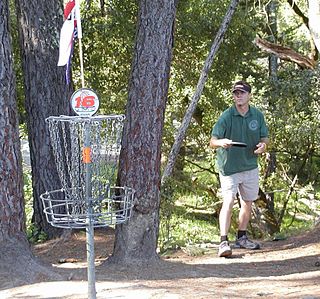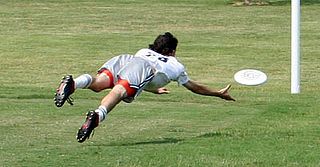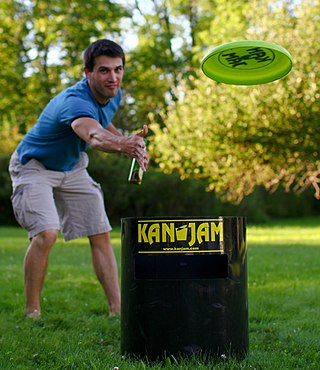
Disc golf, formerly known as frisbee golf, is a flying disc sport in which players throw a disc at a target; it is played using rules similar to golf. Most disc golf discs are made out of polypropylene plastic, otherwise known as polypropene, which is a thermoplastic polymer resin used in a wide variety of applications. Discs are also made using a variety of other plastic types that are heated and molded into individual discs.

A frisbee, also called a flying disc or simply a disc, is a gliding toy or sporting item that is generally made of injection-molded plastic and roughly 8 to 10 inches in diameter with a pronounced lip. It is used recreationally and competitively for throwing and catching, as in flying disc games. The shape of the disc is an airfoil in cross-section which allows it to fly by reducing the drag and increasing lift as it moves through the air, compared to a flat plate. Spinning the disc imparts a stabilizing gyroscopic force, allowing it to be both aimed with accuracy and thrown for distance.

Ultimate, originally known as ultimate frisbee, is a non-contact team sport played with a disc flung by hand. Ultimate was developed in 1968 by Joel Silver in Maplewood, New Jersey. Although ultimate resembles many traditional sports in its athletic requirements, it is unlike most sports due to its focus on self-officiating, even at the highest levels of competition. The term "frisbee" is a registered trademark of the Wham-O toy company, and thus the sport is not formally called "ultimate Frisbee", though this name is still in common casual use. Points are scored by passing the disc to a teammate in the opposing end zone. Other basic rules are that players must not take steps while holding the disc, and interceptions, incomplete passes, and passes out of bounds are turnovers. Rain, wind, or occasionally other adversities can make for a testing match with rapid turnovers, heightening the pressure of play.
Guts or disc guts is a disc game inspired by dodgeball, involving teams throwing a flying disc at members of the opposing team.

Disc dog is a dog sport. In disc dog competitions, dogs and their human flying disc throwers compete in events such as distance catching and somewhat choreographed freestyle catching. The sport celebrates the bond between handler and dog, by allowing them to work together. The term "disc" is preferred because "Frisbee" is a trademark for a brand of flying disc.

Amateur sports are sports in which participants engage largely or entirely without remuneration. The distinction is made between amateur sporting participants and professional sporting participants, who are paid for the time they spend competing and training. In the majority of sports which feature professional players, the professionals will participate at a higher standard of play than amateur competitors, as they can train full-time without the stress of having another job. The majority of worldwide sporting participants are amateurs.

An Aerobie is a flying ring used in a manner similar to a chakram or flying disc (Frisbee), for recreational catches between two or more individuals. Its ring shape of only about 3 mm (0.12 in) thickness makes the Aerobie lighter and more stable in flight than a disc. It can be bent to tune it for straighter flight. Since it has very low drag and good stability, it can be thrown much farther than a flying disc. The Aerobie was used to set two former world records for thrown objects.

The World Flying Disc Federation (WFDF) is the international governing body for flying disc (Frisbee) sports, with responsibility for sanctioning world championship events, establishing uniform rules, setting of standards for and recording of world records. WFDF is a federation of member associations which represent flying disc sports and their athletes in 100 countries. WFDF is an international federation recognized by the International Olympic Committee (IOC), a member of the Association of IOC Recognised International Sports Federations (ARISF), GAISF, and the International World Games Association (IWGA), and it is a registered not-for-profit 501(c)(3) corporation in the state of Colorado, U.S.

Freestyle BMX is bicycle motocross stunt riding on BMX bikes. It is an extreme sport descended from BMX racing that consists of five disciplines: street, park, vert, trails, and flatland. In June 2017, the International Olympic Committee announced that freestyle park was to be added as an Olympic event to the 2020 Summer Olympics.

Flying disc sports are sports or games played with discs, often called by the trademarked name Frisbees. Ultimate and disc golf are sports with substantial international followings.

A lawn game is an outdoor game that can be played on a lawn. Many types and variations of lawn games exist, which includes games that use balls and the throwing of objects as their primary means of gameplay. Some lawn games are historical in nature, having been devised and played in different forms for centuries. Some lawn games are traditionally played on a pitch. Some companies produce and market lawn games for home use in a front or backyard.

Tom Monroe is a champion of virtually all flying disc sports, including ultimate, freestyle, field events and especially disc golf.

Polish horseshoes is an outdoor game played between two teams of two people using a frisbee, two glass bottles or cans, and stakes, ski poles or hiking sticks hammered into the ground. The game is played by the players taking turns throwing a frisbee at a glass bottle that rests on top of the stakes in the ground. The two stakes are placed anywhere between 20 and 40 ft apart. Players must hold a drink in one hand at all times, leaving only one hand free for throwing and catching.

Kan Jam is a flying disc game, played with a flying disc and two cans into which players deflect the disc. Teams of two players take turns tossing a disc between two plastic cans, scoring points if the disc hits or is deflected into one of the cans. The game is played to a target score of exactly 21, but a team can also win if a player throws the disc through the slot or top of a can without the help of their teammate.
Canadian Ultimate Championships (CUC) is an annual Ultimate Frisbee tournament organized by Ultimate Canada and the player association of the city where the championships are held. Until 2016, all divisions were hosted in the same location. Beginning in 2016 the mixed divisions have been held as a separate event.

Ultimate Canada is a not-for-profit organization that serves as the governing body of the sport of Ultimate in Canada. It runs the Canadian Ultimate Championships (CUC) and Canadian University Ultimate Championship (CUUC) series.

Kenneth Ray Westerfield is an American pioneering frisbee disc player, who achieved numerous disc sports accomplishments in the 1970s. A disc sports Hall of Fame inductee in freestyle, ultimate, and disc golf. In addition, he was voted "Top Men's Player" in the 1970-75 Decade Awards. Westerfield produced tournaments, set world records, and won awards in every disc sport. He was a tournament co-director for the Canadian Open Frisbee Championships (1972-1985) in Toronto, the Vancouver Open Frisbee Championships (1974-1977) in Vancouver, BC, the 1978 Santa Cruz Flying Disc Classic in Santa Cruz, California, the 1985 Labatt's World Guts Championships in Toronto, and the 1987 World PDGA Disc Golf Championships in Toronto. Westerfield founded the first ultimate league in Canada - the Toronto Ultimate Club (1979). As one of the original freestylers from the 1960s, used his expertise in several company-sponsored touring Frisbee shows in the U.S. and Canada. Irwin Toy,, Molson Frisbee Team (1974–77), Adidas Canada (1974-1979), Goodtimes Professional Frisbee Show (1978–82), Orange Crush Frisbee Team (1977–78), Air Canada Frisbee Team (1978–79), Lee Jeans Frisbee Team (1979–80) and the Labatts Schooner Frisbee Team (1983–85).

Catch, playing catch, or having a catch, is one of the most basic children's games, often played between children or between a parent and child, wherein the participants throw a ball, beanbag, flying disc or similar object back and forth to each other. At early stages in a child's life, having a catch is a good way to evaluate and improve the child's physical coordination. Notably, "[i]f a child cannot catch a ball that he or she is bouncing, it is unlikely the child will be able to play catch". Most children begin to be able to play catch around the age of four. Many four-year-olds instinctively close their eyes when a ball is heading towards them, and it can take some time to overcome this. Playing catch can help develop dexterity, coordination and confidence.

A falling leaf is a maneuver in which an aircraft performs a wings-level stall which begins to induce a spin. This spin is countered with the rudder, which begins a spin in the opposite direction that must be countered with rudder, and the process is repeated as many times as the pilot determines. During the maneuver, the plane resembles a leaf falling from the sky; first slipping to one side, stopping, and then slipping to the other direction; continuing a side-to-side motion as it drifts toward the ground.
Modern disc golf started in the early 1960s, but there is debate over who came up with the idea first. The consensus is that multiple groups of people played independently throughout the 1960s. Students at Rice University in Houston, Texas, for example, held tournaments with trees as targets as early as 1964, and in the early 1960s, players in Pendleton King Park in Augusta, Georgia would toss Frisbees into 50-gallon barrel trash cans designated as targets. In 1968 Frisbee Golf was also played in Alameda Park in Santa Barbara, California by teenagers in the Anacapa and Sola street areas. Gazebos, water fountains, lamp posts, and trees were all part of the course. This took place for several years and an Alameda Park collectors edition disc still exists, though rare, as few were made. Clifford Towne from this group went on to hold a National Time Aloft record.


















